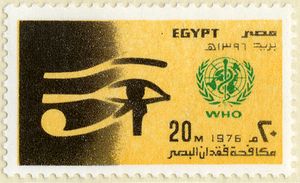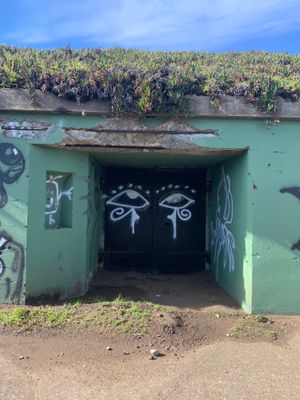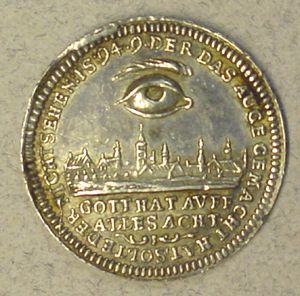Author: Aubrey Minshew, Museum Specialist, Truhlsen - Marmor Museum of the Eye®
Eyes are everywhere! When we were putting together the new special exhibition, “Decoding the Eye: Signs & Symbols,” I started to notice eyes everywhere I went. Eyes popped up in logos, on street signs and in graffiti. I found new images of eyes in many of my old travel photos, and realized eyes were all over my jewelry. It became clear very quickly that many of the eye symbols that we feature in the show are not just relics of history; they’re living and changing icons in all our lives.
For instance, the Eye of Horus, a symbol discussed in the show, has been used for thousands of years. Originally, the Eye of Horus comes to us from ancient Egyptian mythology, symbolizing the eye of the sky deity Horus. Mythology depicts Horus as the son of the god of the underworld, Osiris, and his sister-wife Isis, goddess of healing. In many stories, Horus has one of his eyes plucked out and stolen by another god, Set. Usually, the eye is magically restored, which is why the Eye of Horus was used as a potent symbol of healing. Amulets featuring the Eye of Horus were used as funerary offerings and prayers for healing, and were often wrapped in between the linen layers on a mummified body.

Ancient Egyptian Eye of Horus amulet in the museum collection, c. 2200 BCE–400 BCE
In modern times, the Eye of Horus appears in a wide variety of cultural contexts. It has been used as a symbol of modern Egyptian ethnic and political identity. Almost four thousand years after its original use, it can be found on items like this postage stamp that was issued during the presidency of Anwar Sadat in 1976.

Egyptian postal stamp honoring the World Health Organization, 1976
Outside of Egypt, it can also be seen as a protective symbol in popular art and graffiti. In fact, this spring, I ran across graffiti of the Eye of Horus while hiking in the Marin Headlands outside of San Francisco. If you start paying attention, you’ll see the Eye of Horus pop up all over in tattoos, jewelry and other works of popular culture or new-age artwork.

Eye of Horus graffiti on Battery Smith-Guthrie, Marin Headlands, 2023
Another symbol that transcends time periods and geography is the Eye of Providence (also called the Eye of God or the All-Seeing Eye). The Eye of Providence is generally used as a symbol of divine protection and approval, or as a reminder to the faithful that God watches over all. This symbol was very prevalent in Europe and the Americas in the eighteenth and nineteenth centuries, both in Christian communities and secular organizations. An image of a human eye, sometimes inside of a triangle, was depicted in both religious artwork and civic objects, such as on this German silver ducat showing the Eye of Providence watching over an eighteenth-century cityscape with the message Gott Hat Auff Alles Acht (God takes care of everything).

Silver ducat from the Jay M. Galst, MD, Numismatic Collection, c. 1700
In America, we see this symbol almost every day, even if we don’t realize it. If you look at the back of any one-dollar bill, you’ll see the Great Seal of the United States (with the eagle in the below image), which was adopted by the U.S. Congress in 1782. The reverse side of the Great Seal (circled below) depicts an eye in a triangle shape. It’s the Eye of Providence again, this time paired with a thirteen-step pyramid which is meant to represent the thirteen original U.S. colonies. While sometimes attributed to more fanciful meanings, the Great Seal was intended to symbolize the same message as other uses of the Eye of Providence: divine protection and watchfulness.

The front (R) and reverse (L) of the Great Seal of the United States on the back of the one-dollar bill
The Eye of Providence has found its way out of the 18th and 19th centuries. You can find it being used currently around the Mediterranean on the prows of boats; in the logos of universities, Masonic temples and other fraternal orders; and even in the world of music, such as on this 1970 promo poster for the English rock band Pink Floyd.

Promotion for Pink Floyd at the short-lived Fillmore East in New York City
Eyes and vision have always been central to the human experience, so it’s not surprising that they continue to be used as signs and symbols around the world. Next time you travel or just take a walk in your city or town, look out for these eyes in the wild. Keep an ear out for eyes as a metaphor in your favorite songs and think about how you and your community might use eyes as symbols today. Once you start paying attention, you’ll be pleasantly surprised by how much you can see.
“Decoding the Eye: Signs and Symbols” is on display until April 2024, and many of these images are being displayed in a special in-gallery video this summer. Learn more at https://www.aao.org/museum/special-exhibitions.